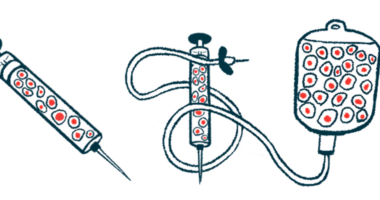Safety being seen in first 3 patients in stem cell therapy clinical trial
Aspen's ANPD001 aims to replace dopaminergic neurons in the brain

Reasonable safety is being seen in a first group of Parkinson’s disease patients who finished dosing in a Phase 1/2a clinical trial of ANPD001, Aspen Neurosciences’ investigational stem cell therapy aiming to replace the nerve cells lost to the disease.
The three treated adults were given two sequential escalating doses of the therapy injected directly into the brain while under general anesthesia. At one to three months later, they are showing no serious complications, and no one had severe blood loss during the surgery, known as an intraoperative hemorrhage.
The most common adverse event was “mild to moderate tongue swelling in all 3 participants due to the surgical procedure in the prone position,” scientists reported in a recent oral update on trial findings at the MDS International Congress of Parkinson’s Disease and Movement Disorders in Philadelphia.
“Tremendous progress” has been made “since launching the study earlier this year,” Edward Wirth III, MD, PhD, chief medical officer of Aspen Neuroscience, said in a company press release.
ANPD001 involves changing skin cells into stem cells that can produce dopamine
Parkinson’s is caused by the gradual loss of nerve cells called dopaminergic neurons, which make the chemical messenger dopamine that helps to control movement. The lack of dopamine signaling leads to an array of disease motor symptoms like tremors, rigidity, and slowed movements.
Treatment options for Parkinson’s focus on boosting or modifying dopamine signals in the brain, requiring continuous administration of medications.
ANPD001 is a cell replacement therapy based on a patient’s own induced pluripotent stem cells (iPSC), a type of stem cell that can become almost any cell type in the body.
This process involves collecting skin cells from patients, which are turned into iPSCs under a controlled biological and chemical environment. These cells then are converted into neuronal precursor cells capable of producing dopamine.
The neural precursors are injected directly into a specific brain called the putamen by a neurosurgeon, guided with the help of magnetic resonance imaging (MRI). The treatment’s goal is for these cells to mature and replace the neurons lost to Parkinson’s, becoming long-term dopamine producers able to slow or stop disease progression.
The putamen, part of a brain region called the dorsal striatum, is involved in movement and known to be particularly affected by Parkinson’s disease.
Treatment safety is a main goal, followed by changes in motor symptoms
The ASPIRO Phase 1/2a clinical trial (NCT06344026) is assessing ANPD001’s safety and tolerability in up to nine adults with moderate to severe Parkinson’s, ages 50 to 70, invited to participate at one of five U.S. sites. Treatment effectiveness, a secondary study goal, is being measured by changes in on time, defined as periods without troublesome dyskinesia (involuntary movements), changes in other measures of Parkinson’s motor symptoms, and improvements in quality of life.
After the transplant, participants will be followed for up to five years to check cell survival. Long-term safety will be assessed annually for an additional 10 years via telephone calls.
The trial, which began patient dosing in April, is being supported by an $8 million grant given to Aspen by the California Institute for Regenerative Medicine.







